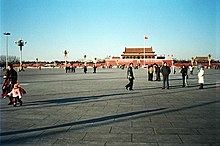
Tian'anmen Square (simplified Chinese: ?ì°???????; traditional Chinese: ?ì°?éT?V??; pinyin: Ti¨?n'¨?nmén Gu¨?ngch¨?ng) is the large plaza near the centre of Beijing, China, named after the Tiananmen (literally, Gate of Heavenly Peace) which sits to its north, separating it from the Forbidden City. It has great cultural significance as it was the site of several key events in Chinese history.
The Tiananmen Square is the largest city square in the world (440,000 m² - 880 m by 500 m) . It has been the site of many events, among which a gathering of pro-democracy protesters in 1989. The protest ended when hundreds[citation needed] of these protesters were killed by government troops in the streets leading from the square.
History

The Tiananmen Gate was first built in 1417 in the Ming Dynasty. During the demise of the Ming Dynasty, heavy fighting between Li Zicheng and the early Qing emperors damaged (or perhaps destroyed) the gate. The Tian'anmen square was originally designed and built in Beijing in 1651.[1] It was enlarged to its present size (four times its original size) and cemented over in 1958.[2]
British and French troops who invaded Beijing in 1860 pitched camp near the gate and briefly considered burning the gate and the entire Forbidden City down. They decided ultimately to spare the palace and to burn instead the emperor's Old Summer Palace. The Qing emperor eventually agreed to let the foreign powers establish headquarters in the area. During the Boxer Rebellion of 1900 the siege badly damaged the office complexes and several ministries were burnt down. In the conflict's denouement, the area became a space for foreign troops to assemble their armies and horses. It was cleared in due course to produce the beginning of what is now known as the Tiananmen Square.
Near the centre of today's square, close to the site of the Mao Zedong Mausoleum, once stood one of the most important gates of Beijing. This gate was known as the "Great Ming Gate" (?ó?÷??) during the Ming Dynasty, "Great Qing Gate" (?ó????) during the Qing Dynasty, and "Gate of China" (??????) during the Republic of China era. Unlike the other gates in Beijing, such as the Tiananmen and the Qianmen, this was a purely ceremonial gateway, with three arches but no ramparts, similar in style to the ceremonial gateways found in the Ming Dynasty Tombs. This gate had a special status as the "Gate of the Nation", as can be seen from its successive names. It normally remained closed, except when the Emperor passed through. Commoner traffic was diverted to two side gates at the northern and eastern ends of today's square, respectively. Because of this diversion in traffic, a busy marketplace, called Chessgrid Streets (??????) developed in the big, fenced square to the south of this gate. In the early 1950s, the Gate of China (as it was then known) was demolished along with the Chessgrid Streets to the south, completing the expansion of Tiananmen Square to (approximately) its current size.
Features
Used as a massive meeting place since its creation, its flatness is broken only by the 38-metre (125 ft) high Monument to the People's Heroes completed in 1958, and the Mausoleum of Mao Zedong completed in 1977.[2] The square lies between two ancient, massive gates: the Tian'anmen to the north and the Zhengyangmen, better known as Qianmen (simplified Chinese: ?°??; traditional Chinese: ?°éT; pinyin: Qiánmén; literally "Front Gate") to the south. Along the west side of the Square is the Great Hall of the People. Along the east side is the National Museum of China (dedicated to Chinese history predating 1919). Chang'an Avenue, which is used for parades, lies between the Tian'anmen and the Square. Trees line the east and west edges of the Square, but the square itself is open, with neither trees nor benches. The Square is lit with huge lampposts which also sport video cameras. It is heavily monitored by uniformed and plain clothes policemen.
Events
Tiananmen Square has been the site of a number of political events and student protests. These include the May Fourth Movement in 1919; the proclamation of the People's Republic of China by Mao Zedong on October 1, 1949; annual mass military displays on all subsequent National Days until October 1, 1959; the 1984 military parade for the 35th anniversary of the People's Republic of China and the 50th anniversary in 1999; and for mass rallies during the Cultural Revolution.
- Tiananmen Square protests in 1976 after the death of premier Zhou Enlai
- Tiananmen Square Protests of 1989
Images from near and in the square
Railway station
Zhengyangmen gate

Monument to the People's Heroes, with the Mausoleum of Mao Zedong

Monument in front of Mao's Mausoleum on Tiananmen Square

Monument to the People's Heroes and the Great Hall of the People

Tiananmen gate to the Forbidden City with reviewing stands in front

Iconic image of the Tiananmen Square from the May Fourth movement of 1919

Overview of the Tiananmen Square
From:http://en.wikipedia.org/wiki/Tiananmen_Square
Address: ROOM 103, No 10 Ti Yu Guan Rd, Chongwen District, Beijing
copyright@2010北京百达旅游有限公司



